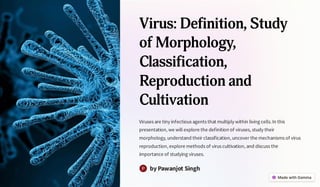
Virus
- 1. Virus: Definition, Study of Morphology, Classification, Reproduction and Cultivation Viruses are tiny infectious agents that multiply within living cells.In this presentation, we will explore the definition of viruses, study their morphology, understand their classification, uncover the mechanisms of virus reproduction, explore methods of virus cultivation, and discuss the importance of studying viruses. by Pawanjot Singh P
- 2. Definition of a Virus Avirus is asmall nucleoprotein complex and submicroscopic infectious agent, replicates only inside the living cell(host cell) of other organisms such as animals and plants.They consist of asingle type of nucliec acid that serves as genetic material,iether DNAor RNA,surrounded by aprotein coat called acapsid. Properties of viruses: They do not have cellular organization. They contain only one type of nucleic acid either DNAor RNA. They lack enzymes for protein synthesis. They multiply by complex process but not by binary fission. They are unaffected by antibacterial antibiotics.
- 3. Structure Viruses are acellular that means they do not have cells as it has no nucleus, cytoplasm or organelles.They consists of two main parts viz.nucleic acid and capsid.In nucleic acid, DNAor RNAis found at the core of the virus .The nucleic acid is linear or circular and either segmented.Capsid is a protein which is surrounded by the genetic material. protein coat is made up of repeating sub-units known as capsomeres.
- 4. Study of Virus Morphology Icosahedral Symmetry Many viruses have a symmetrical/icosahedral shape with 20 triangular faces. This geometric arrangement provides stability and structural integrity. These viruses have 12 vertices(corners) and 30 edges and is made up of equilateral triangles fused symmetrically. Icosahedral morphology is sometimes also reffered to as polyhedral/cubic morphology. Example: Poliovirus and Adenovirus. Helical Symmetry These viruses have ahelical structure, with aspiral arrangement of protein subunits surrounding their genetic material.This allows for flexibility and versatility in shape. These viruses are also called spiral symmetry. Most of these viruses are enveloped and all of them contain RNAproteins. Example:Tobacco mosaic virus. Complex Symmetry They have complexicity in their structure and do not show icosahedral or helical symmetry. They do not have any 1 particular type of virus structure and most of them are combination of the helical and cubical structures. Most of these viruses consists of head and tail. Example:Poxvirus.
- 5. Classification of Viruses 1 Genetic Material Viruses can be classified based on their genetic material, either DNAor RNA, and whether it is single-stranded or double-stranded. 2 Host Range Viruses can also be classified based on the types of organisms they infect, such as animals, plants, or bacteria. 3 Site of Replication Viruses can also be classified based on the site they attack and replicate on, most of the viruses replicate on cytoplasm or nucleus of the host others replicate through RNAand DNA. 4 Capsid Structure The shape and structure of the capsid can also be used to classify viruses into different families such as cubical, spiral and complex. 5 Mode of Transmission Some viruses are transmitted through direct contact, while others are transmitted through avector like mosquitoes.
- 6. Reproduction of Viruses LYTIC CYCLE: Attachment The virus attaches to the surface of the host cell using specific molecules on its capsid. Entry The genetic material is injected into the host cell either by direct penetration or by the fusion of its envelope with the host cell membrane. Replication The virus uses the host cell's machinery to replicate its genetic material and produce new viral components. Assembly The newly replicated viral components are assembled into complete viruses. Release Then finally virus enzymes causes the cell to burst and the viruses are released from the host cell.These new viruses further infect to other cells and the process continues.
- 7. Reproduction of Viruses LYSOGENIC CYCLE : Attachment The virus attaches to the surface of the host cell using specific molecules on its capsid. Entry The virus enters the host cell either by direct penetration or by the fusion of its envelope with the host cell membrane. Integration The viral genome integrates into the host cell and starts the next phase i.e., the replication. Replication When the host cells replicates, the viral DNAis copied along with the host cell DNA. Each new daughter cell is infected with the virus Induction When the infected cells are exposed to certain environmental conditions, viral DNAis activated and enters the lytic cycle. Replication The virus takes over the cells metabolism, causing the creation of new proteins and nucleic acid by the host cell's organelles. Assembly The newly replicated viral components are assembled into complete viruses. Release Then finally virus enzymes causes the cell to burst and the viruses are released from the host cell.These new viruses further infect to other cells and the process continues.
- 8. Cultivation of Viruses 1 Animal Models Viruses can be grown and studied in living animals, such as mice or monkeys, to observe their effects and develop vaccines. 2 Cell Culture Viruses can be cultivated using cell cultures, where they infect and replicate within specific types of cells grown in a lab. 3 Egg Cultivation Some viruses, like influenza, can be grown in fertilized chicken eggs, providing asystem for large-scale virus production.
- 9. Importance of Studying Viruses 1 Disease Prevention Studying viruses helps us understand how they cause diseases, leading to the development of vaccines and antiviral drugs. 2 Emerging Infections By studying viruses, we can monitor and respond to emerging infections, such as the recent COVID-19 pandemic. 3 Biotechnological Applications Viruses are used in biotechnology to deliver genetic material into cells, develop gene therapies, and produce vaccines.
- 10. Conclusion The study of viruses is essential for understanding infectious diseases, developing treatments, and advancing biotechnology.By unraveling the mysteries of these microscopic agents, we can protect human and animal health, and improve our quality of life.